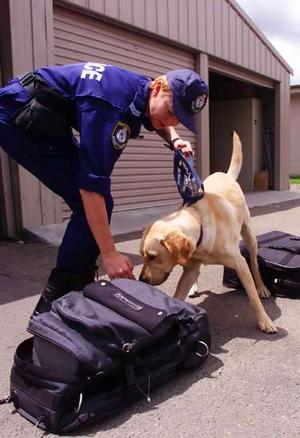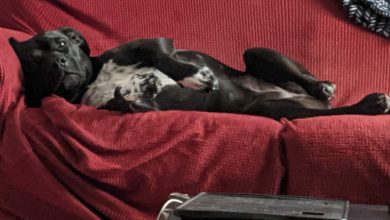Quickies
Skepchick Quickies 1.6

- Andrew Wakefield sues Brian Deer, the BMJ, and Fiona Godlee – More from Orac here.
- Not a misogynist, maybe just a sexist? – From the wonderful new More Than Men project.
- Ban the use of drug dogs now – Science seems to show that drug-sniffing dogs are more likely reacting to their handler’s behavior than to the scent of drugs. What does this mean for all the other trained dogs we use, like cadaver dogs, agricultural dogs (who make sure you’re not smuggling plants), and fire/bomb dogs?
- Mysterious female super hero helps Beijing’s poor – From Mark.
- Cute Animal Friday! From nowoo, here’s an adorable froggy. Proof that you don’t have to be a vertebrate to be cute, a baby slug from jes3ica. And from Michael, a cat who doesn’t take kindly to singing birthday cards.





Ugh, thanks for that.
*wipes of MMR conspiracy slime*
Wow, I really feel dirty, shouldn’t have read the comments at RI. Need to take a sh…
Oh look, a cute… err, slug?
Awww, how cute. Wait, is that frog flipping me off?
Oh, great! Now I’m infected with the paranoia.
You meant to do that didn’t you?
I hope you’re happy.
hoppy
Damnit, you’re on to my plan!
I blogged about the problems with sniffer dogs almost a year ago. I still think it’s a surprising and unfortunate result. Luckily, there are animals with great noses that care a lot less about what we think than dogs do. Just look at Bart Weetjens landmine -detecting rats! I’m sure people who are buried in rubble will be grateful to be rescued even it means being found by a rat.
I have read about the landmine detecting rats, which are so very cool.
When it comes to dogs finding people under rubble or in the snow and stuff like that, dogs do save lives and are often the only thing we’ve got to find these people. So in my opinion, dogs can still be used in those fields where errors by the dogs won’t lead to people getting arrested for no reason.
Thanks for the link to “Not a misogynist, maybe just a sexist?” I sent it to a man of my acquaintance who likes to defend his use of “bitch” with “it’s just a female dog.”
Barf.
I’d say;
And a male chicken is called a cock. Mind if I call you a cock?
Disclaimor: The war on drugs is complete and utter bullshit and I favor legalization.
Parsing the dog issue down to just the question: Do drug sniffing dogs suffer from the clever hans effect? The answer is clearly, based on this one blog post, we have no frigging idea.
The dogs may very well be hitting on residue. The fact that the searches turn up nothing 50% or more of the time does not defacto mean that the Clever Hans effect is in play. Until you have the double blind studies where the effect is ruled out or confirmed, calling for a ban on drug sniffing dogs and labelling the cops who use them as racist profiling assholes is a bit extreme.
There’s plenty of reasons to talk about racist cops and the use of profiling in law enforcement but this argument is fallacious.
Erik, did you follow the link in the Pandagon story to the next step? There’s a lot more detail about a study done by a Dr Lisa Lit of UC Davis of 18 dogs and their handlers and 144 trials. There is link there to a story in the Economist with a little more detail. There’s no reference I could find to the actual publication, but this certainly warrants more Googling.
There is also a link in the ObsidianWings post to a Chicago Tribune report on a study the newspaper did on Illinois statistics of police searches of cars in suburban Chicago based on drug-sniffing dogs. That’s where the dismal false-positive rates came from. The Tribune study cites limited statistics (neither the Chicago Police nor the Illinois State Police provided them with any data) and some of the tests or demonstrations which purportedly showed that trained dogs could detect drugs and drug residues seemed pretty dicey. I couldn’t tell if they were even single-blinded.
Both the Economist and the Tribune cited the Clever Hans effect. I think that’s pretty good news for skeptics; they must be reading their Ray Hyman and James Randi. (Or Milbourne Christopher, who seems to be the first modern writer to discuss the case.) There’s a good summary with lots of references on The Skeptic’s Dictionary.
TL;DR These looks like a subject with lots of woo potential which should be thoroughly investigated by proper double-blind studies. It all could be valid or it could be just as bogus as the infamous ADE 651 bomb detectors.
Rats: link tag close fail… All the highlighted link takes you to the ObsidianWings story, except the last word, “Economist”, which goes directly to the story there.
Oh, and me, too on your disclaimer.
My first thought reading “Science seems to show that drug-sniffing dogs are more likely reacting to their handler’s behavior than to the scent of drugs” was YOU GOTTA BE KIDDING!
I’m a dog trainer. I don’t train a lot of scent and I have not trained specifically to scent drugs at all. But I am currently training one of my dogs (my lab) to scent for an invasive plant species.
Both of my dogs, as one would expect, know my scent very well. My lab has found the glove that I lost and perhaps hundreds of training bumpers. I’ve been in countless situations with her where if she could not find “it” —- I was not going to get “it” back (because I had no idea where “it” was).
My mix-breed (German Shepherd-Rottweiler-Lab) is a “natural tracker.” I can (and have) depended on her to find our trail (and our way back to the truck) when I have lost my way while hiking.
In competition obedience (specifically, AKC Utility Dog), dogs find articles by scent alone. The judge plants the article (which has the handler’s scent) amongst nine identical others which do not have the scent. The handler sends the dog to the pile of articles. After the initial send, the handler must stand straight up with arms & hands at their sides. It is part of the judge’s job to disqualify any handler who gives any form of additional signal…and the judge is REALLY looking. Yep, a handler could attempt to give a facial expression as a signal BUT the dog’s head is usually down when it sniffs the articles that are on the floor, the handler would be cheating, the handler would get disqualified if caught, other competitors would become angry, and the judge could lose future work if the “cheat” was not called-out.
There are numerous other situations where dogs find specific scents that are in areas completely out-of-sight and previously unknown by the handler such as animal scat of endangered species.
Scent training is 100% about the human-dog communication. A handler needs to let the dog know what they are looking for and then allow the dog to find it. The dog must be able to signal the handler when they have found that object. A handler could tell a dog to find wolf scat. The dog may run a quarter of a mile away from the handler into the woods. The dog will find the scent and grab the dowel attached to its collar. The dog will then run a quarter mile back to the handler. When the dog returns, the handler knows the scat has been found (dog holding the dowel is the signal). The dog will then lead the handler to the scat.
In the absolute very first stages of training, the handler will know where the desired object is (in fact, they probably placed that object). But extremely quickly (like maybe even in the first session – depending on the dog and what kind of training) the training will mandate that the handler NOT know where the object is. In many cases, it can be severely counter-productive to attempt to help the dog. Attempting to help the dog can result in complete failure if the handler is actually depending on the dog to find the object (or trail). It will cause the dog to become confused. There should be a clear distinction between directing the dog to the object and allowing the dog to find the object.
Most working dogs are trained to do both directed retrieving and hunting with scent. Hunting retrievers often need to use both skills in order to make one retrieve.
So my thought after READING the article and thinking about dog training as I know it, is that there is probably a problem with the cops —- not the dogs, the dogs’ initial training, or using dogs for scent work.
If a cop attempts to help the dog find the drugs, he certainly could pull the dog off of the actual scent.
If a handler-dog team spend too much time with directed retrieving, the dog can become too reliant on the handler. This is a somewhat common problem for some hunting dogs that constantly need to use and train both skills. Handlers and trainers certainly should be aware of it.
If a cop directs the dog to “hit” on a scent that is not there, he is RUINING that dog’s training!
PS: With some dogs, there is always a problem with them “hitting” on food instead of the desired scent.
Thanks, washu, for your excellent informed input. I have one quibble though:
In the trials where the judge places the object, are both the judge and the handler visible to the dog?
It seems to me that both would need to be out of sight in order to rule out the Clever Hans effect.
Your final conclusion, that the police handlers are the problem, makes sense to me. The effectiveness depends on the two working as a team, right?
Also, I have a thought. Do the dog/handler teams undergo regular quality control exercises? Surely a double blind setup could and should be incorporated into these.
“In the trials where the judge places the object, are both the judge and the handler visible to the dog?”
When the judge places the object, he/she is not visible to the dog or the handler. The handler stands motionless next to the dog. The judge, the handler, and the dog all know that the target is in the pile with all the other identical looking objects. The judge will know which one it is. To qualify the dog must determine, by scent alone, which one it is. The handler may or may not know which one it is.
When the dog is finding the object, both the judge and handler are in the ring (50′ square area) and would be visible to the dog if the dog looked to them. This is not a scientific experiment. It is hobby / sport. However, the “clever hans effect” is avoided at all costs. It is considered cheating and moreover counter-productive. If cheating (or unintentional cues) is suspected, the dog-handler team is disqualified.
The dogs with good training, typically run straight to the object and pick it up straight away (they can smell the one with the strongest scent before they get to the pile). Dogs with less training or practice, sometimes need to “hunt” for the object (Should he pick-up one of the ones that smells like the handler or the one that has the STRONGEST handler scent?) Beginner dogs sometimes get confused between this exercise and plain old retrieving and will pick-up any article. Some other beginners get confused or nervous and stand in the middle of the pile and look to the handler for help. If the help comes (some handlers will chose to help the dog, not as cheating, but as a way to keep the dog’s confidence up), the team is disqualified.
“Do the dog/handler teams undergo regular quality control exercises? Surely a double blind setup could and should be incorporated into these.”
It certainly would and should be a basic and important part of the regular training routine. I would hope that it is. This is part of normal scent training.
******
Reading ABOUT this study actually upset me. It took me a little while to figure out why.
Separating the study, itself, from most people’s comments and opinions of it has helped greatly.
The results of the study, at a glance, are surprising. But, in thinking about it, the study WAS set-up to intentionally mislead the handlers. A similar test where the handlers are told “there may be no target scents at all,” would have most likely have gotten a lot less false positives (if any at all). And in a lot of scent work, there is no scent find – no drugs, no bombs, no wolf poop (while in training there may or may not be a scent to find) The handlers in the study, hopefully, have had a valuable learning experience.
Jumping to the conclusion that all scent-work is accomplished via the “clever hans effect” (or is otherwise pseudoscience) is insulting, incorrect, and impossible.
The “clever hans effect” is not new news. It is an extremely well known phenomenon. It is at the basis of almost all animal training. The animals work for rewards (usually food, praise, or play). Sighted animals refer to the handler’s body language (some individuals more so than others). In agility (where dogs take obstacles at the handler’s command) competition, handlers use both verbal and visual cues. My lab needs much more obvious visual cues than my friend’s Belgian Shepherd who will respond to a small hand movement. This fact effects the way we train and handle our dogs.
While praise is still a big part of scent work, visual cues are not. Most of the time, the dog is not in a position to clearly see the handler (Sometimes the dog is completely out-of-sight). More importantly, in a lot of scent work, the handler does not know where the target is (or if there even is one). If I’m lost in the woods and want my dog to lead me to my truck, I certainly can’t help her scent for the trail. How can I give my dog visual cues when I want her to find my missing glove? Its missing. I don’t know if its to the right, to the left, in a bush, down the hill?
So that study points out that visual cues from the handlers may be interfering with the dogs’ ability to do scent work. This we (trainers) already knew. Could the police use this to single-out people the handler suspects (as opposed to the individuals the dog would otherwise “hit-on” or not) — yes but one would hope not. And even if the police are doing this, it does not discredit all scent work.
Here’s the study:
http://www.springerlink.com/content/j477277481125291/fulltext.html
and a couple more opinion pieces on it:
http://www.psychologytoday.com/blog/minds-animals/201102/when-your-dog-reads-your-subtle-cues
http://www.psychologytoday.com/blog/thinking-about-kids/201103/is-the-science-behind-sniffer-dogs-bogus
That’s not what superhero means.
I do see why she would want to hide her identity though. The article seems as interested in the modesty of her outfit as her deeds.